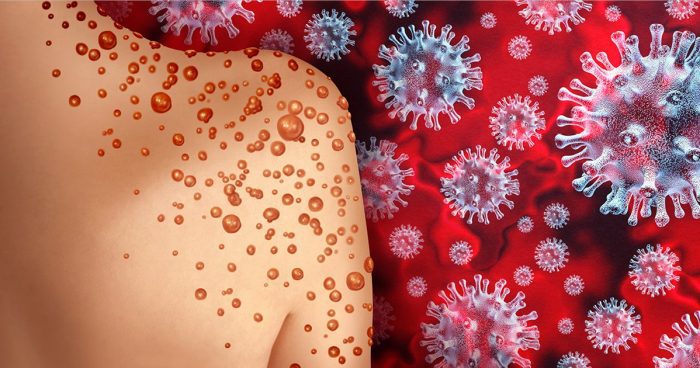Concerns for monkeypox and COVID-19 build for the fall
The reported rate of positive tests for COVID-19 is likely well below the actual infection rate, particularly for the highly-transmissible BA.5 strain of Omicron, health care officials said.
“I expect that we’re at least double, and we’re probably significantly higher than double,” said Dr. Sharon Nachman, chief of the Division of Pediatric Infectious Diseases at Stony Brook Children’s Hospital. “I, like many others, am quite concerned for the fall and winter.”
Indeed, with positive results for PCR tests in the range of 10 to 12% during the summer, the percentage of people who might contract the most infectious variant of the virus yet could surge in the colder months, when students return to school and people spend more time indoors.
The good news so far is that the number of people who have been hospitalized with COVID has stayed relatively steady at Stony Brook University Hospital, at around 50.
Over the past few weeks, the number hasn’t dipped below 40 or gone above 75, which means that the current infections generally aren’t causing hospitalizations, Nachman said.
“While COVID-19 rates may be higher than reported, cases are less severe than they were at earlier stages of the pandemic and hospitalizations are fewer,” Dr. Gregson Pigott, commissioner of the Suffolk County Department of Health Service, explained in an email. “Vaccinations play a large role in the reduction of hospitalizations.”
The number of people hospitalized with COVID on Long Island averages about 450 per day, which is down from 4,000 in April of 2020 and 2,200 in January of 2022, according to the county Department of Health.
Suffolk County hosted a back to school test kit distribution event on Tuesday at the H. Lee Dennison Building for parents and residents.
Raising awareness of monkeypox
At the same time, government and health care officials are dedicating more resources to combat the threat from monkeypox, a virus with symptoms including fever, headaches, exhaustion and a rash that can last two to four weeks.
In Suffolk County, the number of confirmed cases has climbed to 22 as of the beginning of August, according to Department of Health officials.
Working with Northwell Health and Stony Brook University, the county has been providing monkeypox vaccinations. The county expects to get more vaccines later this month, although the demand continues to exceed the supply.
Governor Kathy Hochul (D) declared a state of emergency on July 29 over the outbreak, which will allow a faster response and enhance the distribution of vaccines in the state. The governors of California and Illinois have also declared states of emergency over a virus that is rarely fatal but is painful and can cause scarring. The more vulnerable populations include pregnant women, young children, people who are immunocompromised and individuals who have a history of eczema.
Nachman said the response from the governor was a “way of getting ahead” of the spread of the virus.
The state of emergency “raises everyone’s concern,” Nachman said. “When you go to a local physician, more people are thinking, looking and testing [for monkeypox]. Testing is critical” to confirm cases and to reduce the spread.
Vaccinations, which involve getting two shots that are four weeks apart, can accelerate the immune response, Nachman said.
Stony Brook hopes in the next few weeks to work on a National Institutes of Health-funded clinical trial with children, pregnant and postpartum women on a potential treatment for the virus.
Spread during physical contact, the large majority of monkeypox cases have occurred among men who have been intimate with other men.
Pigott has been working closely with the community to promote prevention efforts and vaccinations. He spoke on Monday at a forum hosted by the LGBT Network, where he said gay or bisexual men in their 20s and 30s were at the highest risk.
Other viruses
In addition to COVID concerns for the fall, Nachman explained that other seasonal respiratory viruses have become more prevalent and problematic through the summer.
Flu has historically been a winter virus, starting in late November or early December and ebbing in its infectiousness around March.
In 2022, the flu season stretched through June. At the same time, respiratory syncytial virus, or RSV, typically starts in November and lasts through February.
“We had RSV all summer long,” Nachman said. “We never had a break.”
Nachman is concerned that the overlap among the viruses with infection rates may increase at the same time.
“I worry about the juxtaposition with other respiratory pathogens” that have exceeded their usual seasonal limitations, Nachman added.
Those other viruses are highly contagious, but were limited in their spread when people were wearing masks. Once people stopped taking precautions for COVID, these other viruses also spread.
“No one had been exposed, and it was like a match to tinder,” Nachman said. “It spread through the population” after few people had contracted these illnesses.
Health care providers urged people to take several steps to protect themselves, their families, and their communities.
“If you’re sick, please don’t go to work,” Nachman said. ‘If your child is sick, please don’t send them to school.”
People also need to practice safe cough techniques. If they need to cough or sneeze, they should minimize the number of aerosolized particles by covering their nose and mouth or coughing into their clothing.
A plea for proper vaccinations
With a reluctance to return to the widespread use of masks or other restrictions that might limit the spread of COVID, health care officials continue to urge people to benefit from the protection vaccines provide.
Indeed, most of the people who have required more extensive medical care at Stony Brook University Hospital have not been fully vaccinated.
Some of those who have required medical attention received a single dose of a vaccine over two years ago, which is effectively not vaccinated, she said.
Nachman expects that COVID vaccinations may become required as they are for measles mumps and rubella and other diseases for students to attend class in person.
“I do see in the future that will happen,” Nachman said. “Not vaccinating hurts the child and the entire community.”







